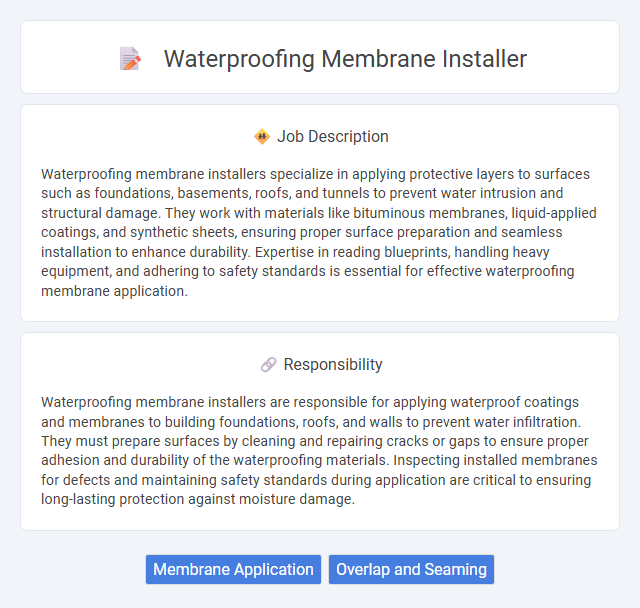
Waterproofing membrane installers specialize in applying protective layers to surfaces such as foundations, basements, roofs, and tunnels to prevent water intrusion and structural damage. They work with materials like bituminous membranes, liquid-applied coatings, and synthetic sheets, ensuring proper surface preparation and seamless installation to enhance durability. Expertise in reading blueprints, handling heavy equipment, and adhering to safety standards is essential for effective waterproofing membrane application.
People with good physical fitness and stamina are likely suitable for a waterproofing membrane installer job due to the demanding nature of lifting, bending, and working in various weather conditions. Those who have a keen eye for detail and can follow technical instructions accurately may have a higher probability of excelling in this role. Conversely, individuals with limited physical endurance or difficulty working in confined spaces might find this job less suitable.
Qualification
A waterproofing membrane installer must possess knowledge of various membrane materials such as bituminous, PVC, and EPDM to ensure effective moisture protection. Proficiency in surface preparation, membrane application techniques, and safety protocols is essential for optimal installation and durability. Certification or training in waterproofing standards and construction site safety enhances job performance and compliance with industry regulations.
Responsibility
Waterproofing membrane installers are responsible for applying waterproof coatings and membranes to building foundations, roofs, and walls to prevent water infiltration. They must prepare surfaces by cleaning and repairing cracks or gaps to ensure proper adhesion and durability of the waterproofing materials. Inspecting installed membranes for defects and maintaining safety standards during application are critical to ensuring long-lasting protection against moisture damage.
Benefit
Waterproofing membrane installers likely increase the durability and longevity of buildings by effectively preventing water infiltration. Their expertise in proper application may reduce the risk of costly repairs and structural damage over time. This specialization probably offers strong job stability due to ongoing demand in construction and maintenance sectors.
Challenge
Waterproofing membrane installers likely face challenges related to ensuring surface preparation meets stringent standards to prevent future leaks. They probably encounter difficulties working in varying weather conditions that could affect application quality and curing time. The role may also demand precision and attention to detail to guarantee the membrane's integrity and long-term performance.
Career Advancement
Waterproofing membrane installers gain expertise in applying specialized materials to prevent water damage in construction projects, which enhances their value in the building industry. Progression opportunities include advancing to supervisory roles, project management, or becoming specialists in advanced waterproofing technologies. Certification and continuous training in new waterproofing methods significantly boost career growth and earning potential.
Key Terms
Membrane Application
Waterproofing membrane installers specialize in applying durable, flexible membranes to surfaces like roofs, basements, and foundations to prevent water infiltration. Precision in surface preparation and membrane alignment is critical to ensure seamless adhesion and long-term waterproofing performance. Expertise in using tools such as rollers, heat welders, and adhesives optimizes membrane application, safeguarding structures from moisture damage.
Overlap and Seaming
Waterproofing membrane installers ensure precise overlap and seaming to create a continuous barrier against moisture penetration. Proper overlap, typically 2 to 4 inches depending on manufacturer specifications, prevents water infiltration at membrane joints. Seam integrity is reinforced by techniques such as heat welding, adhesive bonding, or pressure rolling to achieve durable, watertight seals essential for long-term structural protection.
 kuljobs.com
kuljobs.com